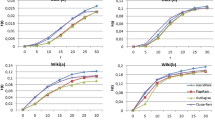Abstract
Identifying the influential spreaders is an important issue in understanding and controlling the spreading processes in social networks. The key to the influential spreader identification problem is how to evaluate the spreading ability of the nodes. Centralities such as degree, semi-local centrality, betweenness, closeness, k-shell are usually used as evaluation metric. However, we observe that these centralities are sensitive not only to the spreading probability, but also to the network structure. We are not sure which centrality is efficient when we face a new network. In this paper, we propose a robust method named Adjustable multi-Hops Spreading (AHS). In AHS, we refine the influence of a node into direct influence and indirect influence, and then integrate them with a adjustable parameter. The experimental results in both real social networks and artificial networks show that AHS outperforms other centralities in effectiveness, robustness and the distinguish ability.











Similar content being viewed by others
References
Bae J, Kim S (2014) Identifying and ranking influential spreaders in complex networks by neighborhood coreness. Phys A Stat Mech Appl 395(4):549–559
Barabsi AL, Albert R, Jeong H (1999) Mean-field theory for scale-free random networks. Phys A Stat Mech Appl 272(1C2):173–187
Boguñá M, Pastor-Satorras R, Daz-Guilera A, Arenas A (2004) Models of social networks based on social distance attachment. Phys Rev E Stat Nonlinear Soft Matter Phys 70(70):148–168
Chen D, Linyuan L, Shang MS, Zhang YC, Zhou Tao (2012) Identifying influential nodes in complex networks. Phys A Stat Mech Appl 391(4):1777–1787
Dangalchev C (2006) Residual closeness in networks. Phys A Stat Mech Appl 365(2):556–564
Dong LI, Zhi-Ming XU, Sheng LI, Liu T, Wang Xiu Wen (2014) A survey on information diffusion in online social networks. Chin J Comput 254(3):31–36
Gao S, Ma J, Chen Z, Wang G, Xing C (2014) Ranking the spreading ability of nodes in complex networks based on local structure. Phys A Stat Mech Appl 403(6):130–147
Katz L (1953) A new status index derived from sociometric analysis. Psychometrika 18(1):39–43
Katz E (1957) The two-step flow of communication: An up-to-date report on an hypothesis. Public Opin Q 21(1):61–78
Kendall MG (1938) A new measure of rank correlation. Biometrika 30(1–2):81–93
Kitsak M, Gallos LK, Havlin S, Liljeros F, Muchnik L, Stanley E, Makse HA (2010) Identification of influential spreaders in complex networks. Nature Phys 6(11):888–893
Kleinberg JM (1999) Authoritative sources in a hyperlinked environment. J ACM 46(5):604–632
Liu L, Zhang YC, Chi HY, Tao Z (2011) Leaders in social networks, the delicious case. Plos One 6(6):e21202
Leskovec J, Krevl A (2014) SNAP datasets: stanford large network dataset collection. http://snap.stanford.edu/data
Leskovec J, Kleinberg J, Faloutsos C (2006) Graph evolution: densification and shrinking diameters. Physics 1(1):2
Leskovec J, Lang KJ, Dasgupta A, Mahoney MW (2008) Community structure in large networks: natural cluster sizes and the absence of large well-defined clusters. Internet Math 6(1):29–123
Liu JG, Ren ZM, Guo Q (2013) Ranking the spreading influence in complex networks. Phys A Stat Mech Appl 392(18):4154C4159
Liu Y, Tang M, Zhou T, Do Y (2015) Core-like groups result in invalidation of identifying super-spreader by k-shell decomposition. Sci Rep 5:9602
Lou T, Tang J (2013) Mining structural hole spanners through information diffusion in social networks. In: International conference on World Wide Web, pp 825–836
Ma Q, Ma J (2016) Identifying and ranking influential spreaders in complex networks with consideration of spreading probability. Phys A Stat Mech Appl 465:312–330
Mislove A, Marcon M, Gummadi KP, Druschel P, Bhattacharjee B (2007) Measurement and analysis of online social networks. In: Proceedings of the 5th ACM/usenix internet measurement conference (IMC’07), San Diego, CA
Page L, Brin S, Motwani R, Winograd T (1999) The PageRank citation ranking: bringing order to the web. Stanford InfoLab
Tang L, Liu H (2010) Community detection and mining in social media. Synth Lect Data Min Knowl Disc 2(1):1–137
Walker SK (2011) Connected: the surprising power of our social networks and how they shape our lives. J Family Theory Rev 3(3):220–224
Wu XD, Li Y, Li L (2014) Influence analysis of online social networks. Chin J Comput 4:735–752
Yang L, Qiao Y, Liu Z, Ma J, Li X (2016) Identifying opinion leader nodes in online social networks with a new closeness evaluation algorithm. Soft Comput 1–12
Zeng A, Zhang CJ (2012) Ranking spreaders by decomposing complex networks. Phys Lett A 377(14):1031–1035
Acknowledgements
This work was funded by the Natural Science Foundation of China (61672322, 61672324, 61272240), the Natural Science Foundation of Shandong province (2016ZR E27468, ZR2012FM037) and the Fundamental Research Funds of Shandong University.
Author information
Authors and Affiliations
Corresponding author
Ethics declarations
Conflict of interest
Author Qian Ma declares that she has no conflict of interest. Author Jun Ma declares that he has no conflict of interest.
Ethical approval
This article does not contain any studies with human participants performed by any of the authors.
Additional information
Communicated by V. Loia.
Rights and permissions
About this article
Cite this article
Ma, Q., Ma, J. A robust method to discover influential users in social networks. Soft Comput 23, 1283–1295 (2019). https://doi.org/10.1007/s00500-017-2847-5
Published:
Issue Date:
DOI: https://doi.org/10.1007/s00500-017-2847-5




